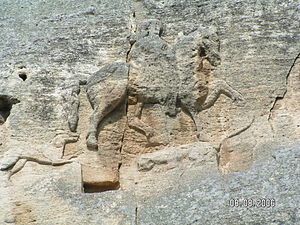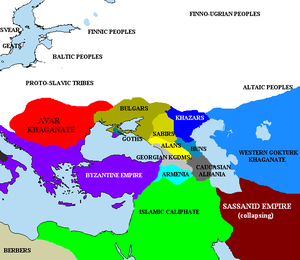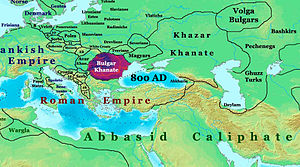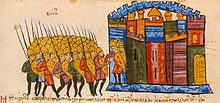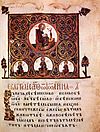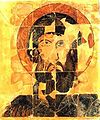- Bulgars
-
Not to be confused with Bulgarians.
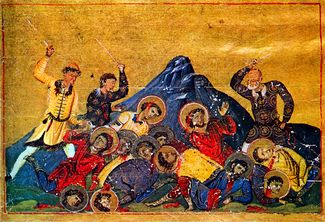 Victorious Bulgar soldiers killing their East Roman (Byzantine) opponents, from the Menology of Basil II, 10th century.
Victorious Bulgar soldiers killing their East Roman (Byzantine) opponents, from the Menology of Basil II, 10th century.
The Bulgars (also Bolgars, Bulghars, Huno-Bulgars[1] or Proto-Bulgarians) were originally semi-nomadic people, probably originating in Central Asia. Ethnically, the Bulgars comprised Turkic and probably Scytho-Sarmatian elements.[2][3] They had enveloped also other ethnic groups by their migration westwards across Eurasian steppe.[4][5] who from the 2nd century onwards settled in different parts of Europe. In the 7th century the Bulgars established the states of Great Bulgaria, Volga Bulgaria and the First Bulgarian Empire in three separate locations of the continent. The Bulgar language spoken by the Bulgar elites was a member of the Oghuric branch of the Turkic language family, alongside with Hunnic, Khazar and Turkic Avar.[6] Initially the Bulgars conquered the steppes north of the Caucasus and around the banks of the river Volga (then Itil). Between 377 and 453 AD the Bulgars, alongside the Huns, conquered territories well into Central and Western Europe. After Attila's death in 453, and the subsequent disintegration of the Hunnic Empire, the Bulgars dispersed mostly to the eastern and southeastern parts of Europe. Archaeological finds from the Ukrainian steppe suggest that the early Bulgars had the typical culture of the nomadic equestrians of Central Asia, who migrated seasonally in pursuit of pastures. From the 7th century, however they rapidly began to settle down, planted crops and became skilled blacksmiths, stone masons and carpenters. Almost all researches consider the influence of the neighbouring Sarmatians, as the main factor that changed the Bulgars' material culture.[7] Some historians claim the Bulgars to be of mixed Sarmatian origin.[8] Contemporaneous sources like Procopius, Agathias and Menander called the Bulgars "Huns"[9] while others, like the Byzantine Patriarch Michael II of Antioch, called them "Scythians" or "Sarmatians", but this latter identification was probably due to the Byzantine tradition of naming peoples geographically. Due to the lack of definitive evidence, a modern scholarship instead uses an ethnogenesis approach in explaining the Bulgars' origin.
In modern ethnic nationalism, there is some "rivalry for the Bulgar legacy" (see Bulgarism.)[10][10][11] The Volga Tatars and Chuvash are said to be descended from the Bulgars, as well as (possibly) the Balkars.
Contents
Name
In modern scholarship, the name Bulgar is generally derived from the Turkic verb bulğa ("to mix", "shake, "stir") and its derivative bulgak ("revolt", "disorder").[12] Others[who?] derive it from the cognate Mongolic bulğarak ("to separate", "split off")[citation needed] or from bel ("five") gur ("Ogurs").[13]
Ethnicity and language
Racial type and descendants
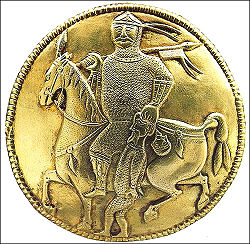 Victorious Bulgar warrior with captive, featured on an ewer from the Treasure of Nagyszentmiklos.[14]
Victorious Bulgar warrior with captive, featured on an ewer from the Treasure of Nagyszentmiklos.[14]
Traditionally, historians have associated the Bulgars with the Huns, who migrated out of Central Asia. Anthropological data collected from medieval Bulgar necropolises from Dobrudja, Crimea and the Ukrainian steppe have shown that Bulgars were a Caucasoid people with a small Mongoloid admixture and practiced circular type artificial cranial deformation.[15][16][17][18][19][20] This finding is consistent with a model in which the Turkic languages were gradually imposed in Central Asia and East European Plain on Caucasian (Scythian) peoples with relatively little genetic admixture, another possible example of a language shift through elite dominance.[21][22] Genetic and anthropological researches have shown that the Eurasian steppe's tribal unions of history were not ethnically homogeneous, but rather unions of multiple ethnicities such as Turkic, Ugric and Iranic among others. Skeletal remains from Central Asia, excavated from different sites dating between the 15th century BC to the 5th century AD, have been analyzed. The distribution of east and west Eurasian lineages through time in the region agrees with available archaeological information. Prior to the 13th - 7th century BC, all samples belong to European lineages; later, an arrival of East Asian sequences that coexisted with the previous genetic substratum was detected.[23]
Ibn Fadlan, who visited Volga Bulgaria in the 10th century, describes the appearance of the Bulgars as "ailing" (pale) and "not ruddy" like the Rus' people. [24]
Both the present-day Bulgarians and the Chuvash far to the east in the Urals are believed to originate partly from the Bulgars. However, according to DNA data, the genetic backgrounds of the two populations are clearly different. The Chuvash have an Eastern European and some Mediterranean genetic background (probably coming from the Caucasus), while the Bulgarians have a classical Mediterranean composition, probably coming from the Balkans. It is possible that only a cultural and low genetic Bulgar influence was brought into the two regions, without modifying the genetic background of the local populations.[25] It is assumed, because the Balkan Bulgars were not numerous,[26][27] the Bulgarian DNA profile is congruent with those described for most European populations, but the greatest contribution comes from the range expansion of local Mesolithic foragers.[28][29] Genetically, modern Bulgarians are more closely related to other neighbouring Balkan populations, than to the rest of the Europeans.[30][31][32][33][34].
Language and culture
Main article: Bulgar languageThe origin and the language of the Bulgars has been the subject of debate since the turn of the 20th century. The current leading theory[35] is that at least the Bulgar elite spoke a language that, alongside Khazar and Chuvash, was a member of the Oghuric branch of the Turkic language family.[36][37][38][39] This theory is supported, among other things, by the fact that some Bulgar words contained in the few surviving stone inscriptions[40] and in other documents (mainly military and hierarchical terms such as tarkan, bagatur, and probably khan and kanartikin - "prince") appear to be of Turkic origin and written in Kuban alphabet of the Old Turkic script. Also, the Bulgar calendar had a 12-year cycle, similar to the one adopted by Turkic and Mongolian peoples from the Chinese, with names and numbers that are deciphered as Turkic. The Bulgars' supreme god was apparently called Tangra, a deity widely known among the Turkic peoples under names such as Tengri, Tura etc.[41]. It should be noted that a number of Pamirian/Iranic words have been found in the Bulgar language[42], and modern day Bulgarian language.
Some also point out the presence of Turkic loanwords in the Slavic Old Bulgarian language and Church Slavonic language, [43] and the fact that the Bulgars used an alphabet similar to the Turkic Orkhon script, this alphabet was deciphered and analyzed by S.Baichorov: [44] fortunately, the Bulgar inscriptions were sometimes written in Greek or Cyrillic characters, most commonly in Greek, thus allowing the scholars to identify some of the Bulgar glosses. Contemporaneous sources like Procopius, Agathias and Menander called the Bulgars "Huns",[45] while others, like the Byzantine Patriarch Michael II of Antioch, called them "Scythians" or "Sarmatians", but this latter identification was probably due to the Byzantine tradition of naming peoples geographically. Due to the lack of definitive evidence, modern scholarship instead uses an ethnogenesis approach in explaining the Bulgars' origin. There are also a number of Iranic words in modern Bulgarian, inheritted from the Bulgars
Further evidence culturally linking the Danubian Bulgar state to Turkic steppe traditions was the layout of the Bulgars' new capital of Pliska, founded just north of the Balkan Mountains shortly after 681. The large area enclosed by ramparts, with the rulers' habitations and assorted utility structures concentrated in the center, resembled more a steppe winter encampment turned into a permanent settlement than it did a typical Roman Balkan city."[46]
On the other hand some modern Bulgarian scientists link it to the Iranian language group instead.[47][48][49][50] However, most of them still assume an intermediate stance, only pointing out certain signs of Iranian influence in the Turkic base, without drawing such conclusions from them,[51][52][53] or indeed actively oppose the "Iranian" theory.[54][55]
With the adoption of Islam of the Volga Bulgars, Arabic script replaced the Bulgar runes, and two styles of calligraphy – Qufi and Thuluth – became particularly popular. The literary Bulgar language that emerged during the twelfth century became the vehicle of communication for the new written culture. The ethnic and cultural kinship enjoyed by the Turkic tribes living on the territory of the Bulgar state, along with the increasing centralization, made possible the emergence of such a language, which rendered the existing dialectal differences less significant even if it could not erase them entirely. The existence of a literary language had a profound effect on education, and in turn, that language was enriched by the fruits of education. The Muslim Volga Bulgars had schools where secular subjects received as much attention as the teaching of the religious dogma. In addition to training future ulama (Islamic scholars) and government bureaucrats, these schools provided at least basic literacy for the majority of the population. [56]
Many Bulgar scholars of the twelfth and thirteenth centuries gained fame and recognition beyond the shores of the Volga and Kama. Al-Garnati was impressed by the work of historian Yakub ibn-Noman, who wrote a history of the Bulgars in 1112. Ibn-Noman was not unique; Burhaneddin Ibrahim ibn-Yusuf had become famous with his books on rhetoric, medicine, and religious commentaries; and no less prominent were the ulama and scholars such as Hamid ibn-Idris, Ahmed al-Bulghari, Muhammed Sadr ibn-Alaeddin, Hasan ibn-Orner, and Muhammed al-Bulgari.[57]
Unfortunately, history has preserved the name of just one Bulgar poet of this period: Kul Gali. His poem «Kyssa-i Yusuf» has been of interest to literary historians and linguists alike as an outstanding example of the spiritual legacy of thirteenth-century Bulgar society.[58]
Culture and society
The Madara Rider (c. 710), a famous example of Bulgar art
Archaeological finds from the Ukrainian steppe suggest that the early Bulgars had the typical culture of the nomadic equestrians of Central Asia, who migrated seasonally in pursuit of pastures. From the 7th century, however they became a settled culture, planting crops, and mastering the crafts of blacksmithing, masonry, and carpentry.
Social structure
The Bulgars had a well-developed clan system and were governed by hereditary rulers. The members of the military aristocracy bore the title boyil (boyar). There also were bagains - lesser military commanders. The nobility were further divided onto Small and Great Boyars. The latter formed the Council of the Great Boyars and gathered to take decisions on important state matters presided by the khan (king). Their numbers varied between six and twelve. These probably included the ichirgu boyil and the kavkhan (vice khan), the two most powerful people after the khan. These positions were administrative and noninheritable. The boyars could also be internal and external, probably distinguished by their place of residence — inside or outside the capital.[40] The heir of the throne was called kanartikin. Other subroyal titles used by the Bulgarian noble class include boyila tarkan (possibly the second son of the khan), kana boyila kolobur (chief priest), boritarkan (city mayor).
That the early Bulgar rulers used the title khan is only an assumption, since the evidence for it is scanty and only suggestive. There is the event of the Bulgarian ruler, Pagan being called "Καμπαγάνος" (Kampaganos) by Patriarch Nicephorus (Nikephoros) in the Patriarch's so called Breviarium, at the end of section 16. The editors of a Bulgarian edition of this source have claimed (via an annotation) that "Kampaganos" is a corruption of "Kan Pagan".[59][60] There is a word kanasubigi in stone inscriptions, which some historians presume is a compound of kana, the archaic form of 'khan'. Among the proposed translations for the phrase kanasubigi are 'lord of the army', from the reconstructed Turkic phrase *sü begi, paralleling the attested Old Turkic sü baši,[40] and, more recently, '(ruler) from God', from the Indo-European *su- and baga-, i.e. *su-baga (a counterpart of the Greek phrase ὁ ἐκ Θεοῦ ἄρχων, ho ek Theou archon, which is common in Bulgar inscriptions).[61] This titulature presumably persisted until the Bulgars adopted Christianity.[62] Some Bulgar inscriptions written in Greek and later in Slavonic refer to the Bulgarian ruler respectively with the Greek title archon or the Slavic title knyaz.[63]
Religion
Very little is known about the religion of the Bulgars. It is supposed to have been monotheistic on the evidence of Greek language inscriptions from pagan Danube Bulgaria, wherein Bulgar monarchs describe themselves as "ruler from God" and appeal to the deity's omniscience and justice. (The various monarchs are not identified by their personal name.) Presian's inscription from Filipi (837) states:
When someone seeks the truth, God sees [it]. And when someone lies, God sees [it]. The Bulgars have done much good to the Christians [meaning the Byzantines] and the Christians have forgotten [that], yet God sees [it all]".
It is traditionally assumed that the God in question was the Turkic sky god Tengri, with few occurrences of that name in documents related to Bulgaria. One such occurrence is in a late Turkish manuscript listing the names of the supreme god in different languages, which has "Tangra" for Bulgarian.[64] Another, from a severely damaged Greek language inscription found on a presumed altar stone near Madara, tentatively deciphered by Beshevliev as "(Kanasubig)i Omu(rtag), ruler (from God), was ... and sacri(ficed to go)d Tangra ...(some Bulgar titles follow)."[65] Beshevliev has also conjectured that the frequent Danube Bulgar runic sign ıYı (i.e.



 ) stands for "Tangra", as it seems to disappear after the conversion to Christianity.
) stands for "Tangra", as it seems to disappear after the conversion to Christianity.A piece of ethnographic evidence which has been invoked to support the belief that the Bulgars worshipped Tengri/Tangra is the relatively similarity of the name "Tengri" to "Tură", the name of the supreme deity of the traditional religion of the Chuvash, who are traditionally regarded as descendants of the Suvar branch of the Volga Bulgars.[66] Nevertheless, the Chuvash religion today is markedly different from Tengriism and can be described as a local form of polytheism with some elements borrowed from Islam. In addition, there was the cult of the worship of Tangri-khan (called Aspandiat by the Persians) by the population of the Hun capital Varachan (i.e. Belenjer/Belendjer, "army head" [quarter]) [67] in Northern Dagestan, which is mostly known as "Kingdom of the Huns" [68] but which Russian historian M. I. Artamonov considered to be ethnically Bulgar. The cult involved sacrifice of horses and use of sacred trees in worship.[69]
D. Dimitrov has argued that the Bulgars also adopted elements of Iranian religious beliefs. He sees Iranian influences on the cult at Varachan and notes resemblances between the layout of the Zoroastrian temples of fire and what seem to be pagan Bulgar sanctuaries at Pliska, Preslav, and Madara. The architectural similarities include two squares of ashlars inserted one into another, oriented towards the summer sunrise. One of these sites was transformed into a Christian church, which is taken as evidence that they served a religious function.[70]
Officially Christianity was adopted in Danubian Bulgaria by Knyaz Boris I in 865 (as a state religion). Islam was officially adopted in Volga Bulgaria as a state religion in 922, but old religion revolts continued into the Mongol conquest in 1230's.
History
Migration to Europe
In the early 2nd century, some groups of Bulgars migrated from Central Asia to the European continent and settled on the plains between the Caspian Sea and the Black Sea. The Bulgars appear (under the ethnonym of ‘Bulensii’) in certain Latin versions of Ptolemy’s 2nd century AD mapping, shown as occupying the territory along the northwest coast of Black Sea east of Axiacus River (Southern Bug).[71][72][73]
Between 351 and 389, some of the Bulgars crossed the Caucasus to settle in Armenia. Toponymic data testify to the fact that they remained there and were eventually assimilated by the Armenians.
Swept by the Hunnish wave at the beginning of the 4th century, other Bulgar tribes broke loose from their settlements in Central Asia to migrate to the fertile lands along the lower valleys of the rivers Donets and Don and the Azov seashore, assimilating what was left of the Sarmatians. Some of these remained for centuries in their new settlements, whereas others moved on with the Huns towards Central Europe, settling in Pannonia.
Those Bulgars took part in the Hun raids on Central and Western Europe between 377 and 453. After the death of Attila in 453, and the subsequent disintegration of the Hunnish empire, the Bulgar tribes dispersed mostly to the eastern and southeastern parts of Europe.
At the end of the 5th century (probably in the years 480, 486, and 488) they fought against the Ostrogoths as allies of the Byzantine emperor Zeno. From 493 they carried out frequent attacks on the western territories of the Byzantine Empire. Later raids were carried out at the end of the 5th century and the beginning of the 6th century.
In the middle of the 6th century, war broke out between the two main Bulgar tribes, the Kutrigur and Utigur. To the west, the Kutrigurs fell under Avar dominion and became influential within the Khaganate. The eastern Utigurs fell under the western Göktürk empire in 568.
The Bulgars (namely those that lived east of Asov), have also sometimes been linked to the Cimmerians, said to be descendants from them (becoming the Utigurs later on, according to Prokoppius). Osman Karatay (In search of the lost tribe: the origins and making of the Croatian nation) also notes that according to the Tarih, there were two people called Utih and Xot, whose ancestors were the Cimmerians (cf. Prokoppius: Utigurs are Kimmerians). Many would object to this idea however, by arguing that the Bulgars were related to the Cimmerians in geography only, since the Bulgars had lived where once the Cimmerians lived [74][75].
The Bulgar Khanate
Further information: Old Great BulgariaUnited under Kubrat of the Dulo clan (identical to the ruler mentioned by Persian chronicler Tabari under the name of Shahriar), the joined forces of the Utigur and Kutrigur Bulgars, and probably the Bulgar Onogurs, broke loose from the Turkic khanate in the 630s. They formed an independent state, the Onogundur-Bulgar (Oghondor-blkar or Olhontor-blkar) Empire, often called by Byzantine sources "the Old Great Bulgaria". The empire was situated between the lower course of the Danube to the west, the Black Sea and the Azov Sea to the south, the Kuban River to the east, and the Donets River to the north. It is assumed that the state capital was Phanagoria, an ancient city on the Taman peninsula (see Tmutarakan). However, the archaeological evidence shows that the city became predominantly Bulgar only after Kubrat's death and the consequent disintegration of his state.
Subsequent migrations
According to legend, on his deathbed Khan Kubrat commanded his sons to gather sticks and bring them to him, which he then bundled together. He commanded his eldest son Batbayan (also Bayan or Boyan) to break the bundle. Bayan failed against the strength of the combined sticks, and so did the other sons in turn. Kubrat undid the bundle and broke each stick separately. He then proclaimed to his sons, "unity makes strength", which has become a commonplace Bulgarian folk slogan and now appears on the modern Bulgarian coat of arms. (Similar versions of this story occur also in Chinese and Japanese historic legends, as well as in the legend of Oghuz Khan and his six sons.)
The Byzantine Patriarch Nikephoros I of Constantinople relates that Kubrat's sons, however, did not live up to this advice,[citation needed] and thus soon after the death of Kubrat around 665, the Khazar expansion eventually led to the dissolution of Great Bulgaria. Batbayan at first remained the ruler of the lands north of the Black and the Azov Seas, but the Khazars soon subdued him. Those Bulgars, along with their Khazar masters, converted to Judaism in the 9th century. Furthermore, the Balkars in Kabardino-Balkaria may be also the descendants of this Bulgar branch.[citation needed]
The Eastern Bulgars, led by Kubrat’s second son Kotrag, migrated to the confluence of the Volga and Kama Rivers in what is now Russia (see Volga Bulgaria). The present-day republics of Tatarstan and Chuvashia are traditionally considered to be the descendants of Volga Bulgaria in terms of territory and people, but recent DNA research casts doubt on this tradition in regard to the Chuvash. Linguistically, only the Chuvash language is similar to the old Bulgar language[76][77][78]; the Tatar language belongs to a different branch of the Turkic languages.
The Bulgars led by Khubrat's youngest son, Asparukh, moved westward and occupied what is today the southern part of Bessarabia. He was followed by 40,000 to 50,000 Bulgars.[79][80][81] After a successful war with Byzantium in 680, Asparukh's khanate settled in Dobrudja. Asparukh and Byzantine Constantine IV Pogonatus signed a treaty in 681. Asparukh's khanate went on to conquer Moesia Superior. The year 681 is usually regarded as the year of the establishment of modern Bulgaria.
The smallest successor group to Great Bulgaria, the Alcek (also transliterated as 'Altsek' and 'Altcek' or 'Ducca Alzeco'), after many wanderings settled mainly near Naples in the Benevento and Salerno provinces, under the leadership of Emnetzur.
A group of Bulgars ruled by Kuber inhabited Pannonia. After breaking free of Avar overlordship, they migrated to Macedonia.[82] This group, numbering around 70,000,[83] included descendants of Roman captives of various ethnicities that had been resettled in Pannonia by the Avars.[84][85] The majority of historians do not see any evidence for the existence of a Bulgar khanate in Macedonia before 850 AD[citation needed]; but Zlatarski posits that Kuber was also a son of Kubrat, that Kuber's Bulgars formed a khanate in Macedonia, and that Kuber's khanate joined Slavs to attack the Byzantine Empire.
The legacy of the Bulgars endured and, in the nineteenth century, was so tangible that Russian historian S. M. Solov'ev reflected: "For a long time Asia, Muslim Asia built here a home; a home not for nomadic hordes but for its civilization; for a long time, a commercial and industrial people, the Bulgars had been established here. When the Bulgar was already listening to the Qur'an on the shores of the Volga and the Kama, the Russian Slav had not yet started to build Christian churches on the Oka and had not yet conquered these places in the name of European civilization". [86]
See also
- Bulgar language
- Bulgarians
- Madara Rider
- Volga Bulgaria
- Balkar
- Bolghar
- Yuezhi
- Kuber
- Mount Imeon
- Old Great Bulgaria
Notes
- ^ The Early Medieval Balkans: A Critical Survey from the Sixth to the Late Twelfth Century, John Van Antwerp Fine, Publisher University of Michigan Press, 1991, ISBN 0472081497, p. 76.
- ^ Encyclopaedia Britannica Online
- ^ Rasho Rashev, Die Protobulgaren im 5.-7. Jahrhundert, Orbel, Sofia, 2005. (in Bulgarian, German summary)
- ^ The New Cambridge medieval history, Volume 4, Part 2, Cambridge University Press, 1995, ISBN 052136292X, p. 229.
- ^ http://www.kroraina.com/p_bulgar/p_bulg2a.htm
- ^ Encyclopaedia Britannica Online - Bulgars
- ^ Pamjatniki Nizhnego Povolzh’ja. Tom I. - Materialy i issledovanija po arheologii SSSR, 60, 1959; K.Smirnov. Sarmatskie plemena Severnogo Prikaspija. - Kratkie soobshtenija Instituta istorii material’noj kul’tury, XXXIV, 1950, s.97, 114.
- ^ .P. Smirnov, Volzhkie bulgary - Trudy GIM, vyp. XIX, M., 1951; V.T. Sirotenko,. Osnovnye teorii proishozhdenija drevnih bulgar i pismennye istochniki IV-VII vv. - Uchjenye zapiski PGU im. Gorkogo, XX, vyp.4 - istoricheskie nauki. Perm, 1961, s 41; Al. Burmov. Kum vaprosa za proizhoda na prabulgarite, s.42-44. - V: Izbrani sachinenija, I. S., 1968.
- ^ The World of the Huns. Chapter IX. Language, by O. Maenchen-Helfen
- ^ a b Viktor Aleksandrovich Shnirelʹman, Who gets the past?: competition for ancestors among non-Russian intellectuals in Russia, Woodrow Wilson Center Press, 1996, ISBN 0-8018-5221-8, 9780801852213. Cf. chapters: The Rivalry for the Bulgar Legacy, The Neo-Bulgarists, etc.
- ^ James Stuart Olson, Lee Brigance Pappas, Nicholas Charles, An Ethnohistorical dictionary of the Russian and Soviet empires, Greenwood Publishing Group, 1994, ISBN 0313274975, 9780313274978, p.114
- ^ Bowersock, Glen W. & al. Late Antiquity: a Guide to the Postclassical World, p. 354. Harvard University Press, 1999. ISBN: 0674511735.
- ^ Karataty, Osman. In Search of the Lost Tribe: the Origins and Making of the Croatian Nation, p. 28.
- ^ Dobrev, Ivan
- ^ D.Dimitrov,1987, History of the Proto-Bulgarians north and west of the Black Sea.
- ^ Сарматски елементи в езическите некрополи от Североизточна България и Северна Добруджа. Елена Ангелова (сп. Археология, 1995, 2, 5-17, София)
- ^ М. Балан, П. Боев. Антропологични материали от некропола при Нови пазар. — ИАИ, XX, 1955, 347— 371
- ^ Й. Ал. Йорданов. Антропологично изследване на костния материал от раннобългарски масов гроб при гр. Девня. - ИНМВ, XII (XVII), 1976, 171-194
- ^ Н. Кондова, П. Боев, Сл. Чолаков. Изкуствено деформирани черепи от некропола при с. Кюлевча, Шуменски окръг. — Интердисциплинарни изследвания, 1979, 3—4, 129— 138;
- ^ Н. Кондова, С л. Чолаков. Антропологични данни за етногенеза на ранносредновековната популация от Североизточна България. — Българска етнография, 1992, 2, 61-68
- ^ Becoming eloquent: advances in the emergence of language, human cognition, and modern cultures, Francesco D'Errico, Jean Marie Hombert, John Benjamins Publishing Company, 2009, ISBN 9027232695, pp. 175-176.
- ^ [Origin and evolution of languages: approaches, models, paradigms, Bernard Laks, Equinox, 2008, ISBN 184553204X, pp. 46-49.]
- ^ Lalueza-Fox, et al. 2004
- ^ R.Frye, Ibn Fadlan's journey to Russia, 2005
- ^ Arnaiz-Villena et al. 2003
- ^ The early medieval Balkans: a critical survey from the sixth to the late twelfth century, John Van Antwerp Fine, University of Michigan Press, 1991, ISBN 0472081497, p. 68.
- ^ The history of the Balkan Peninsula, Eastern Europe Collection, Ferdinand Schevill, Ayer Publishing, 1971, ISBN 0405027745, p. 92.
- ^ Y-Chromosome genetic variation of modern Bulgarians, S. Karachanak et al. European Human Genetics Conference 2011, Amsterdam, May 28–31, 2011.
- ^ Bulgarians vs the other European populations: a mitochondrial DNA perspective, International journal of legal medicine (2011), DOI: 10.1007/s00414-011-0589-y, Karachanak et al.
- ^ Five polymorphisms of the apolipoprotein B gene in healthy Bulgarians.Department of Chemistry and Biochemistry, Medical University of Sofia, Bulgaria.PMID: 12713147
- ^ HLA polymorphism in Bulgarians defined by high-resolution typing methods in comparison with other populations.
- ^ Y-chromosomal diversity in Europe is clinal and influenced primarily by geography, rather than by language
- ^ Distributions of HLA class I alleles and haplotypes in Bulgarians – contribution to understanding the origin of the population. M. Ivanova, P. Spassova, A. Michailova, E. Naumova. Division of Clinical and Transplantation Immunology, Medical University, Sofia, Bulgaria.
- ^ Bulgarian Bone Marrow Donors Registry—past and future directions - Asen Zlatev, Milena Ivanova, Snejina Michailova, Anastasia Mihaylova and Elissaveta Naumova, Central Laboratory of Clinical Immunology, University Hospital “Alexandrovska”, Sofia, Bulgaria, Published online: 2 June 2007
- ^ http://www.csc.kth.se/~dilian/Papers/bulgars.pdf
- ^ Petrov 1981: §A.II.1
- ^ Angelov 1971: §II.2
- ^ Runciman 1930: §I.1
- ^ Siegert 1985: 46
- ^ a b c Beshevliev 1981 (online)
- ^ Sedlar 1994: 141 (Google Books preview)
- ^ http://groznijat.tripod.com/b_lang/
- ^ Tzvetkov P.S., The Turks, Slavs and the Origin of the Bulgarians//The Turks, Vol 1, pp. 562-567, Ankara, 2002, ISBN 975-6782-55-2, 975-6782-56-0
- ^ Baichorov S.Ya., Ancient Turkic runic monuments of the Europe, Stavropol, 1989 (In Russian)
- ^ Maenchen-Helfen 1973: ch. IX
- ^ Hupchick 2001: 10
- ^ Добрев, Петър, 1995. "Езикът на Аспаруховите и Куберовите българи" 1995
- ^ Бакалов, Георги. Малко известни факти от историята на древните българи Част 1 част 2
- ^ Димитров, Божидар, 2005. 12 мита в българската история
- ^ Милчева, Христина. Българите са с древно-ирански произход. Научна конференция "Средновековна Рус, Волжка България и северното Черноморие в контекста на руските източни връзки", Казан, Русия, 15.10.2007
- ^ Бешевлиев, Веселин. Ирански елементи у първобългарите. Античное Общество, Труды Конференции по изучению проблем античности, стр. 237-247, Издательство "Наука", Москва 1967, АН СССР, Отделение Истории.
- ^ Rüdiger Schmitt (Saarbrücken). IRANICA PROTOBULGARICA: Asparuch und Konsorten im Lichte der Iranischen Onomastik. Academie Bulgare des Sciences, Linguistique Balkanique, XXVIII (1985), l, 13-38
- ^ Rasho Rashev. On the origin of the Proto-Bulgarians, p. 23-33 in: Studia protobulgarica et mediaevalia europensia. In honour of Prof. V. Beshevliev, Veliko Tarnovo, 1992.
- ^ Йорданов, Стефан. Славяни, тюрки и индо-иранци в ранното средновековие: езикови проблеми на българския етногенезис. В: Българистични проучвания. 8. Актуални проблеми на българистиката и славистиката. Седма международна научна сесия. Велико Търново, 22-23 август 2001 г. Велико Търново, 2002, 275-295.
- ^ Надпис № 21 от българското златно съкровище “Наги Сент-Миклош”, студия от проф. д-р Иван Калчев Добрев от Сборник с материали от Научна конференция на ВА “Г. С. Раковски”. София, 2005 г.
- ^ For an excellent account of the written culture of the Bulgars, see Gamir Dauletshin, "Bolgar yazma kul'turasy," KU 3 (1980): 176 – 80; also see Kh. R. Kurbatov, Tatar alfavity ham orfografiyase tarikhi' (Kazan, 1960); and G. V. Iusupov, Vvedenie v bulgaro-tatarskuiu epigrafiku (Moscow and Leningrad, 1960).
- ^ Ahmet Temir, "Kuzey Tiirk ebediyati," in Turk Dunyast El Kitabs, vol. 1 (An-kara, 1976), pp. 505-6.
- ^ Nurmokhammat Khisamov, "Adabiyatka tarikhi karash," KU 1 (1981): 184; Mirkassyim Gosmanov, "Yanga sakhifalar ach'ila," KU 10 (1980): 155 – 58. Also see Khisamov's monograph "Kyssa-i Yusuf" Kul' Ali. Analiz istoricheskogo siuzheta i av-torskogo tvorchestva (Moscow, 1979).
- ^ Breviarium of Patriarch Nicephorus, Included in (Bulgarian)Fontes graeci historiae bulgaricae, VI: 305
- ^ Mango 1990: English translation of the Breviarium of Patriarch Nicephorus
- ^ Stepanov 2003
- ^ Sedlar 1994: 46
- ^ Manasses Chronicle, Vatican copy of the Bulgarian translation, p. 145
- ^ Beshevliev 1981: ch. 7
- ^ Beshevliev 1979 Photograph and transcription of the "Tangra" inscription near Madara (Bulgarian)
- ^ Tokarev, A. et al. 1987-1988
- ^ Gmyrya, L. 1995. Hun country at the Caspian Gate: Caspian Dagestan during the epoch of the Great Movement of Peoples. Makhachkala: Dagestan Publishing, pp. 23, 24
- ^ Gmyrya, L. 1995. Hun country at the Caspian Gate: Caspian Dagestan during the epoch of the Great Movement of Peoples. Makhachkala: Dagestan Publishing
- ^ Dimitrov 1987
- ^ Dimitrov 1987
- ^ Dobrev, Petar 2001
- ^ Fries, Lorenz and Claudius Ptolemy. Tabula IX. Europae. In: Servetus, Michael. Opus Geographiae. Lyon, 1535.
- ^ Germanus, Nikolaus and Claudius Ptolemy. Geographia. Ulm: Lienhart Holle, 1482. (fragment)
- ^ Karaty,O. In search of the lost tribe: the origins and making of the Croatian nationpp 24-26
- ^ http://books.google.co.za/books?id=h_Qu1ywX0-wC&printsec=frontcover&source=gbs_ge_summary_r&cad=0#v=onepage&q=bulgar&f=false
- ^ The Uralic language family: facts, myths and statistics, Angela Marcantonio, Wiley-Blackwell, 2002, ISBN 0631231706, p. 167.
- ^ Encyclopedia of the languages of Europe, Glanville Price, Wiley-Blackwell, 2000, ISBN 0631220399, p. 88.
- ^ Studies in Turkic and Mongolic linguistics, Royal Asiatic Society books, Gerard Clauson, Royal Asiatic Society of Great Britain and Ireland, Routledge, 2002, ISBN 0415297729, p. 38.
- ^ Васил Н. Златарски. История на Първото българско Царство. Епоха на хуно-българското надмощие с. 188.
- ^ Ал. Бурмов, Създаване на Българската дъжава с. 132.
- ^ Образуване на българската народност. Димитър Ангелов (Издателство Наука и изкуство, “Векове”, София 1971)с. 203—204.
- ^ Zlatarski 1970 [1918]: 514
- ^ Mikulchik 1996: 71 (§VI.1.Б)
- ^ Hupchick 2001
- ^ Curta 2006
- ^ S. M. Solov'ev, Istoriia Rossii s drevneishikh vremen, vol. 5 – 6 (Moscow, 1959-1965), p. 476.
References
Spelling note: the Bulgarian letter ъ is usually transliterated 'ǎ'. However, variation in the transliteration is found in academic literature and library catalogs in the West, as well as in official Bulgarian transliterations: the alternatives are 'ŭ' and 'y'. The diacritic is often missing. The alternatives 'ŭ' and 'y' can be observed below in the spellings of the common first name, Dimitǎr which have become bibliographically established for particular authors.
The journal FGHB is an occasional journal. BAS publishes other occasional journals each devoted to a different language (e.g., Latin) among the languages in which sources of Bulgarian history were composed.
Sofia is the capital of Bulgaria.
- (Bulgarian) Angelov, Dimitŭr [Димитър Ангелов]. 1971. Образуване на българската народност. Sofia: Nauka i Izkustvo, “Vekove”.
- Arnaiz-Villena, A., et al. 2003. HLA genes in the Chuvashian population from European Russia: Admixture of central European and Mediterranean populations. Human Biology, June 2003.
- (Bulgarian) Beshevliev, Vesselin [Веселин Бешевлиев]. 1979. Първобългарски надписи. Sofia: Bulgarian Academy of Sciences (BAS).
- Beshevliev, Vesselin [Веселин Бешевлиев]. 1981. Proto-Bulgarian Epigraphic Monuments. The original is also available online (Bulgarian): Прабългарски епиграфски паметници. Sofia: Издателство на Отечествения фронт.
- Curta, Florin. 2006. Southeastern Europe in the Middle Ages, 500-1250. Cambridge Univ. Press. Series: Cambridge Medieval Textbooks.
- Dimitrov, Dimityr. 1987. History of the Proto-Bulgarians north and west of the Black Sea. Translated from the Bulgarian, Prabylgarite po severnoto i zapadnoto Chernomorie; Varna. The original is also available online (Bulgarian) here [1].
- (Bulgarian) Dobrev, Ivan [Иван Добрев]. (2005?) Златното Съкровище на Българските Ханове от Атила до Симеон (анотация). Sofia: Rakovski Military Academy [Военна Академия "Г. С. Раковски"]. Compare same title and author except without the анотация (anotacija — annotations): Sofia, Riva, 2005.
- (Bulgarian) Dobrev, Petăr. 2001. Nepoznatata drevna Bălgarija (The Unknown Ancient Bulgaria). Sofia: Ivan Vazov Publishers. ISBN 954-604-121-0.
- Encyclopædia Britannica Online. Bulgars.
- (Bulgarian) and (Greek) Fontes graeci historiae Bulgaricae (FGHB) [Гръцки извори за българската история] (Greek sources of Bulgarian history). Edited by Ivan Dujchev, Genoveva Tsankova-Petkova, et al.. Sofia: Bulgarian Academy of Sciences (BAS), Institute of History [Институт по история]. (In Byzantine Greek and Bulgarian). This content is in the DjVu format and requires corresponding special reader software.
- Hupchick, Dennis P. 2001. The Balkans: From Constantinople to Communism. Palgrave. ISBN 0-312-21736-6.
- Lalueza-Fox, C. et al. 2004. Unraveling migrations in the steppe: mitochondrial DNA sequences from ancient Central Asians. Proc R Sci Lond B [Proceedings of the Royal Society B: Biological Sciences], 2004 May 7; 271(1542): 941–947. (Abstract)
- Maenchen-Helfen. Otto. 1973. The World of the Huns. Univ. of California Press.
- (Bulgarian) Manasses (or Manassia, Manasi), Constantine. 1992 [c. 1187 in Byzantine Greek]. Khronikata na Konstantin Manasi: Zorata na bulgarskata epika. (Bulgarian translation of the Byzantine Greek.) Universitetsko izd-vo "Sv. Kliment Okhridski"
- (English) and (Greek) Mango, Cyril A. 1990. Nikephoros, Patriarch of Constantinople: Short History. Washington, D. C.: Dumbarton Oaks Research Library and Collection. ("Short History" = "Breviarium")
- (Macedonian) Mikulčić, Ivan [Иван Микулчиќ]. 1996. Средновековни градови и тврдини во Македониjа. Skopje: Makedonska Civilizacija. (In Macedonian.)
- (Bulgarian) Petrov, Petǎr [Петър Петров]. 1981. Образуване на българската държава. Sofia: Nauka i Izkustvo.
- Runciman, Steven. 1930. A history of the First Bulgarian Empire. London: G. Bell & Sons.
- Sedlar, Jean W. 1994. East Central Europe in the Middle Ages, 1000-1500. University of Washington Press.
- (Bulgarian) Shishmanov, Ivan [Шишманов, Иван]. 1900. Критичен преглед на въпроса за произхода на прабългарите от езиково гледище и етимологиите на името българин.
- (German) Siegert, Heinz. 1985. Osteuropa—Vom Ursprung bis Moskaus Aufstieg. Panorama der Weltgeschichte, vol. II. Heinrich Pleticha (ed.). Bertelsmann-Lexikon-Verlag.
- Stepanov, Tsvetelin. 2001. The Bulgar title KANAΣYBIΓI: reconstructing the notions of divine kingship in Bulgaria, AD 822–836. Early Medieval Europe, March 2001, 10(1): 1-19. Abstract.
- (Russian) Tokarev, Sergei A et al. 1980. Mify narodov mira (Myths of the world's peoples).
- Zakiev, Mirfatyh [Закиев, Мирфатых]. 2003. Origin of Turks and Tatars. Part II: Origin of Tatars. English translation of Russian language work, Происхождение тюрков и татар.
- (Bulgarian) Zlatarski, V. N. [Васил Н. Златарски]. 1970 [1918]. История на българската държава през средните векове. Sofia: 2nd edition (II изд.) 1970 by Nauka i Izkustvo; 1st edition (I изд.) 1918.
Further reading
- Chance, Jane. 2005. Women medievalists and the academy. Univ. of Wisconsin Press.
- Curta, Florin, ed., with the assistance of Roman Kovalev. 2008. The other Europe in the Middle Ages: Avars, Bulgars, Khazars, and Cumans. BRILL.
- Fine, John V. A. 1991. The Early Medieval Balkans: A Critical Survey from the Sixth to the Late Twelfth Century. University of Michigan Press. ISBN 0-472-08149-7.
- Mango, Cyril A. 2002. The Oxford history of Byzantium.
- Miller, Mikhail. 1956. Archaeology in the U.S.S.R. Frederick A. Praeger.
- Obolensky, Dimitri. 1994. Byzantium and the Slavs. Yonkers, NY: St. Vladimir's Seminary Press.
- Viktor Aleksandrovich Shnirelʹman, Who gets the past?: competition for ancestors among non-Russian intellectuals in Russia, Woodrow Wilson Center Press, 1996, ISBN 0-8018-5221-8, 9780801852213. (Chapter The Rivalry for the Bulgar Legacy at Google Books).
External links
- Bulgarian Academy of Sciences, English language Web portal
- National Institute of Archaeology and Museum (AIM), Bulgarian Academy of Sciences, English language Web portal. (AIM's Bulgarian language Web portal)
- Dumbarton Oaks Research Library and Collection
- History of Bulgaria
- History of the Bulgars
- Bulgars on Regnal Chronologies[dead link]
- The language of the Asparukh and Kuber Bulgars, Vocabulary and grammar, by Peter Dobrev
- Inscriptions and Alphabet of the Proto-Bulgarians, by Peter Dobrev
- On the origins of the Proto-Bulgarians
- Conceptions of Ethnicity in Early Medieval Studies, by Walter Pohl
- History of the Proto-Bulgarians north and west of the Black Sea
- Encyclopaedia Britannica Online - Arrival of the Bulgars
Categories:- Bulgars
- History of Bulgaria
- Turkic peoples
- Moldova in the Early Middle Ages
- Romania in the Early Middle Ages
Wikimedia Foundation. 2010.

